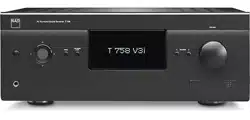Loading ...
Loading ...
Loading ...

ENGLISH
24
DTS
The Digital Theater System Digital Surround (simply called DTS) is a multi-
channel digital signal format that can process higher data rates than with
Dolby Digital. Although both Dolby Digital and DTS are 5.1 channel media
formats, discs bearing the “DTS” symbol are thought to provide better
sound quality due to the lower audio compression required. It also oers a
broader dynamic, producing magnicent sound quality.
A DTS audio input can be congured relative to its format as follows
Stereo: If the detected audio is of DTS format, you can default it to one
of the following settings - Neural:X or None.
Surround: If the detected audio is of DTS Surround format, you can
default it to one of the following settings - Neural:X, Stereo Downmix
or None.
None: If “None” is selected, the DTS signal will be defaulted to its native
format. With this setting, “Direct” becomes available as a Listening Mode
option.
PCM
PCM (Pulse Code Modulation) is the digital representation of a standard
audio signal converted with little or no compression. If “None” is selected,
the audio signal will be defaulted to its native format.
Stereo: The detected stereo audio format will be congured into one
of the following options - Neural:X, Dolby Surround, EARS, Enhanced
Stereo or None.
Surround: The detected surround audio format will be congured
into one of the following options - Neural:X, Dolby Surround, Stereo
Downmix or None.
ANALOG
If the audio input is an analog signal, the following are the surround modes
the input can be defaulted - Neural:X, Dolby Surround, EARS, Enhanced
Stereo, Analog Bypass or None.
NOTE
Applicable Listening Modes can also be directly selected by repeatedly
pressing front panel LISTENING MODE button.
LISTENING MODES
The T 758 oers distinct listening modes, tailored for dierent types of
recording or program material. With a two-channel (Stereo) source, the
following listening modes can be selected.
STEREO
Output is directed to the front left/right channels. Low frequencies are
directed to the subwoofer if one is present in the Speaker settings. Select
“Stereo” when you wish to listen to a stereo (or monaural) production, such
as music CD, without surround enhancement. Stereo recordings whether
in PCM/digital or analog form and whether surround-encoded or not
encoded, are reproduced as recorded. Multi-channel digital recordings
(Dolby Digital and DTS) are reproduced in “Stereo Downmix” mode via the
front left/right channels only as Lt/Rt (left/right-total) signals.
DIRECT
The analog or digital sources are automatically played in their native
formats. All the source’s audio channels are reproduced directly. This
mode recreates the original sound most faithfully thereby producing
outstandingly high quality audio. Note that the source must be at playback
mode for “Direct” to become available as a listening mode option. In order
to automatically playback your source in their native format, implement the
following settings.
1 Go to “Listening Mode Setup” under “Setup Menu”. At the “Listening Modes”
menu, set all Dolby, DTS, PCM and Analog settings to “None”. With this
setup, your source will be played back directly at its native format.
2 Next, go to “A/V Presets” under “Setup Menu”. At “A/V Presets” menu, set
“Listening Mode Setup” item to “Yes” and then save this setting among
other options, say to “Preset 1”, by selecting “Save Current Setup to
Preset”.
3 Now, you can associate “Preset 1” to any of the “Source” settings. For
example, at Source 1 setting under “Source Setup”, scroll down to “A/V
Preset” item and set it to “Preset 1”. Thus whenever Source1 is selected,
the associated source will always be directly played back at its native
audio format.
OPERATION
USING THE T 758 SETUP MENU
Loading ...
Loading ...
Loading ...
